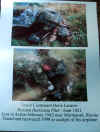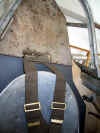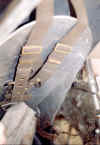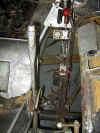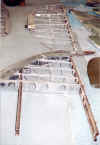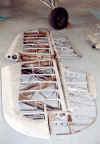Amazing what a difference a few days can make.
I had the opportunity to discuss this aircraft with Chris Vtipil, Project Manager for the Fighter Factory, and he provided me with a full accounting of the incredible history behind this Hurricane. The aircraft was from fifth Hawker-produced production block, begun 14 January 1941 and completed 28 July, 1941. Total block size was 1000, and this aircraft came from a batch of 35 serials between Z2741 and Z2775 (info from the Hawker Hurricane Production Summary site). Chris provided the rest of the aircraft's amazing history and this is given below:
The record card which was obtained from Brooklands shows this Hurricane at the following locations before it was shipped to Russia:
20/02/41 5 MU (Maintenance Unit) Kemble 23/02/41 20 MU Aston Down 18/03/41 310 Squadron Martlesham Heath
(310 Squadron at Duxford at this time)26/06/41 minor accident upon arrival at
Martlesham from Duxford01/07/41 Air Training Ltd. In Kidlington no date 22 MU Silloth no date 82 MU Lichfield for packing 27/10/41 Shipped to Russia The operational diary of 310 squadron shows the following flights and pilots for Hurricane Z2768:
March 23rd 1941
Pilot Sgt. Seda1740 - 1840 Patrolled over the English Channel off Dover with five other Hurricanes Z2312, Z2400, Z2493, Z2661 and Z2671. Sq.Ldr Weber was flying Z2661
March 27th 1941
F/O Hybler12 aircraft were flown to Coltishall at 0605 and flew convoy patrols in pairs all day. Z2768 was one of the second pair which patrolled between 0805 and 0910. Z2770 in Red Section was one of the first pair and successfully intercepted a Ju88. After a lively encounter, in which the raider jettisoned four large bombs, the enemy aircraft was eventually lost in cloud but was later counted as probably destroyed. F/O Hybler in Z2768 flew another (uneventful) patrol between 1545 and 1645
March 30th 1941
Flt.Lt BodicAs on the 27th, 12 aircraft were sent to operate from Coltishall and Flt.Lt Bodic flew two patrols in Z2768 between 1325-1450 and again between 1630-1730.
March 31st 1941
Sgt. SedaOperating once more from Coltishall, Z2768 flew a "Kipper" patrol between 0925 and 1055
April 2nd 1941
F/O HyblerAs one of a pair of "A" Flight Hurricanes forming White Section that day, Z2768 patrolled over Mildenhall between 1135 and 1210.
April 20th 1941
Sgt. SedaBetween 1050 and 1220, Z2768 was one of a pair of Hurricanes which carried out an uneventful operational patrol over Cambridge.
May 18th 1941
two operations on the same daySgt. Jiroudek patrolled between London and Norwich at a height of 21000 feet from 1120 to 1245.
Sgt. Mlejnecky patrolled over Duxford at 26000 feet between 1610 and 1645.
June 15th 1941
two operations in quick successionSgt. Mlejnecky patrolled over Mildenhall between 1335 and 1445
P/O Kimlicka patrolled over the North Sea (at 3000 feet) between 1510 and 1625.
June 17th 1941
two operations flown by P/O Kimlicka0900-0915 (As Yellow section) - patrol over Duxford.
1430-1545 Yellow section sweep over the sea between Southend and Great Yarmouth at 18000 feet.
June 18th 1941
Sq.Ldr WeberWing patrol at 8-12000 feet between North Foreland and Dover with two squadrons operating from West Malling.
June 26th 1941
Sgt. Mlejnecky1425 - 1450 (Yellow Section) one of seven coastal patrols by 14 Hurricanes of 310 squadron on the day the unit moved from Duxford to Martlesham.
If the above is correct, this means that Z2768 was the final victory of Rudi Müller, a leading ace of JG5 "Eismeer" who was shot down in Bf 109G-2 WNr. 14810 "yellow 3 + -" (link to Kjetil Aakra profile) and taken prisoner on 19 April 1943. Although he was reportedly sighted as late as 1947, Müller did not survive Soviet captivity.
As regards Lazarev's unit, the 760 IAP was formed sometime in November or December 1941, and Z2768 was one of 484 Hurricanes taken on strength with the VVS throughout 1941. The notes regarding the aircraft being fitted with Russian armament deserve some explanation. The following translation from Hurricane w obcej sluzie (AJAKS publications) illustrates the rationale of discarding the 8x .303 Brownings:
As early as December 1941, workshops of 72 SAP started to modify the armament, replacing Browning guns with two 12.7 mm (0.5 in) UBK guns with 100 rounds per gun, or with ShVAK cannon. Some aircraft were converted to carry a single FAB-50 bomb under each wing. The latter modification was first suggested by Capt. Boris Safonov, OC 78 IAP. Another variant of armament modification consisted in replacing 4 Browning guns with two UBK ones. Apart from changes in armament, Safonov also had the pilot's seat armour replaced in his aeroplane, using one from a crashed I-16.
Apart from conversions made on an individual basis in combat units, the VVS HQ decided to replace armament and cockpit armouring in all Mark IIA and IIB aircraft. In March 1942 a national level decision was made to re-arm all Hurricanes with more powerful domestic armament. Three variants of the new armament were considered: the first consisted of four 20 mm ShVAK cannon; the second of two ShVAK cannon and two 12.7 mm UBT guns; and the last of four UBT guns. The latter proved the best solution. As the Russians did not have enough of the UBT guns, the second variant was introduced. During this conversion, Hurricanes were also fitted with rails for RS-82 rocket missiles and with bomb racks.Conversion started at the Moscow-based Factory no. 81. Pilots delivered the aircraft directly to the factory airfield. Apart from the Factory no. 81, conversions were also made at Podmoskove, Podlipki - 6 IAK PVO repair workshops. Apart from conversions made behind the lines, teams of workers from the Factory no. 81 were sent to the front line, where they would make the conversions in field, almost under combat conditions. The work was carried out at airfields of Kubinka, Khimki, Monino, Yegorevka. In all the Russians fitted their armament to some 1,000 Mk IIAs and IIBs.
In the photos below, there are a couple of specific items to look for which are different from other Hurricanes; firstly, it carries Russian-made tires (the Cyrillic lettering can just be made out in the wheel photo). And second, there are a number of small switch panels around the instrument panel coaming which were locally installed items... these would be control switches for the Russian armament installed as noted above.
On a personal note, it is certainly sobering to be in the presence of this aircraft, knowing the incredible history behind it. How many more amazing stories and lost airmen await recovery in the bogs, lakes, and wastelands of the Northern Front?
